Custom Lint rules
Improve your code quality
with dedicated conventions


André Diermann
Software Architect @ it-objects
Our motivation for custom Lint rules
In words
- enterprise mobility solution
(> 10.000 users in EU, Asia, USA) - several developers working distributed
in different countries - complex business logic due to full offline mode
- custom application architecture
- huge code base
Our motivation for custom Lint rules
In numbers
- 32 build variants
- >2.000 classes in ~100 packages
(with ~150.000 lines of code) - >200 screens with >1.500 widgets
(>30.000 lines of XML) - >3.500 string references
(>35.000 translations) - ...
Agenda
- Introduction
- Lint API basics
- Hands-on: custom Lint rules
- Real world scenarios
- Q & A
Introduction
- Lint
- Custom rules
- Challenges
Lint
- tool for command-line and IDE
- scans all kind of development artifacts
- reports potential bugs, bad coding habits, broken conventions, ...
- features more than 200 built-in checks (January 2015)
Example
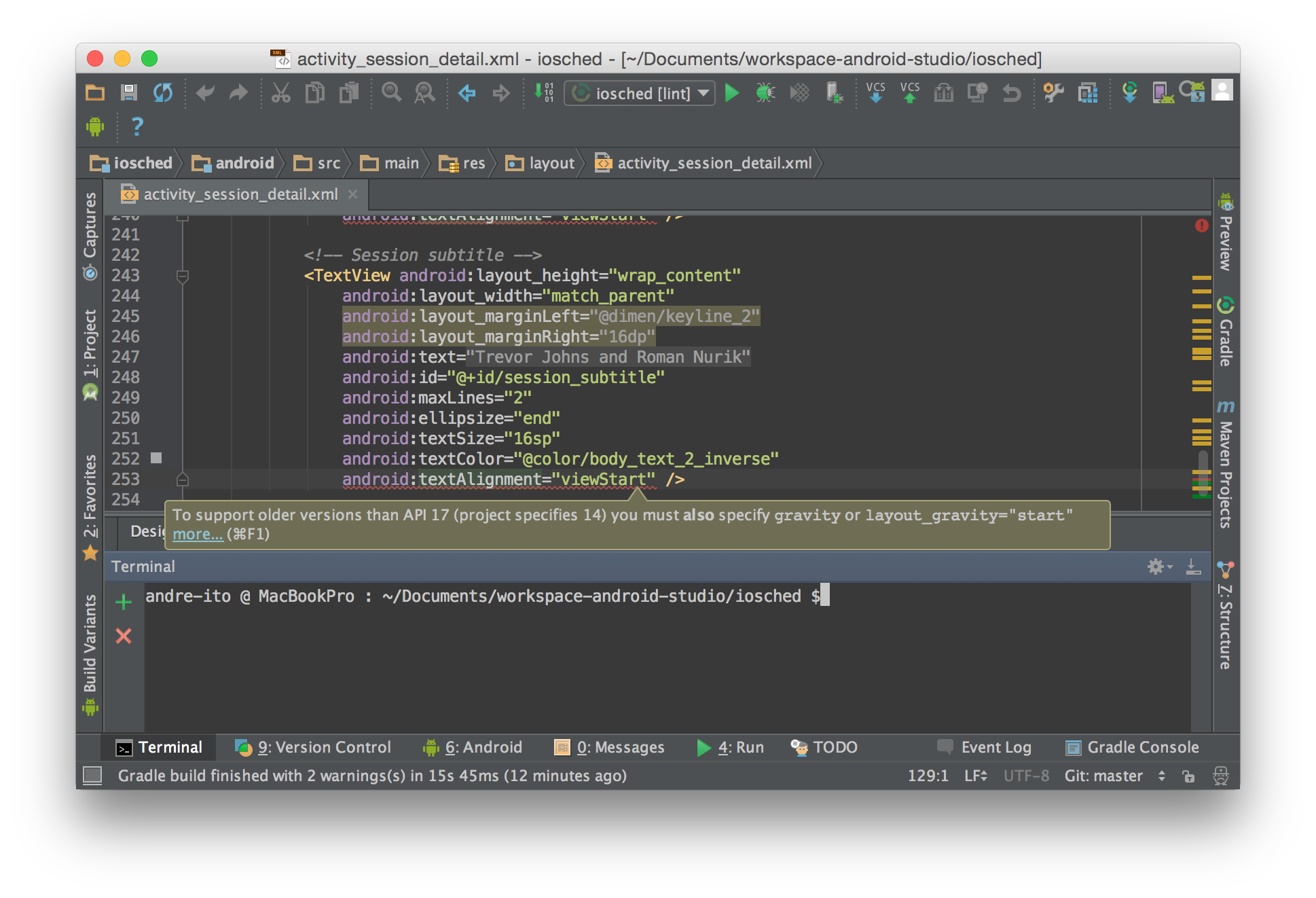
Example
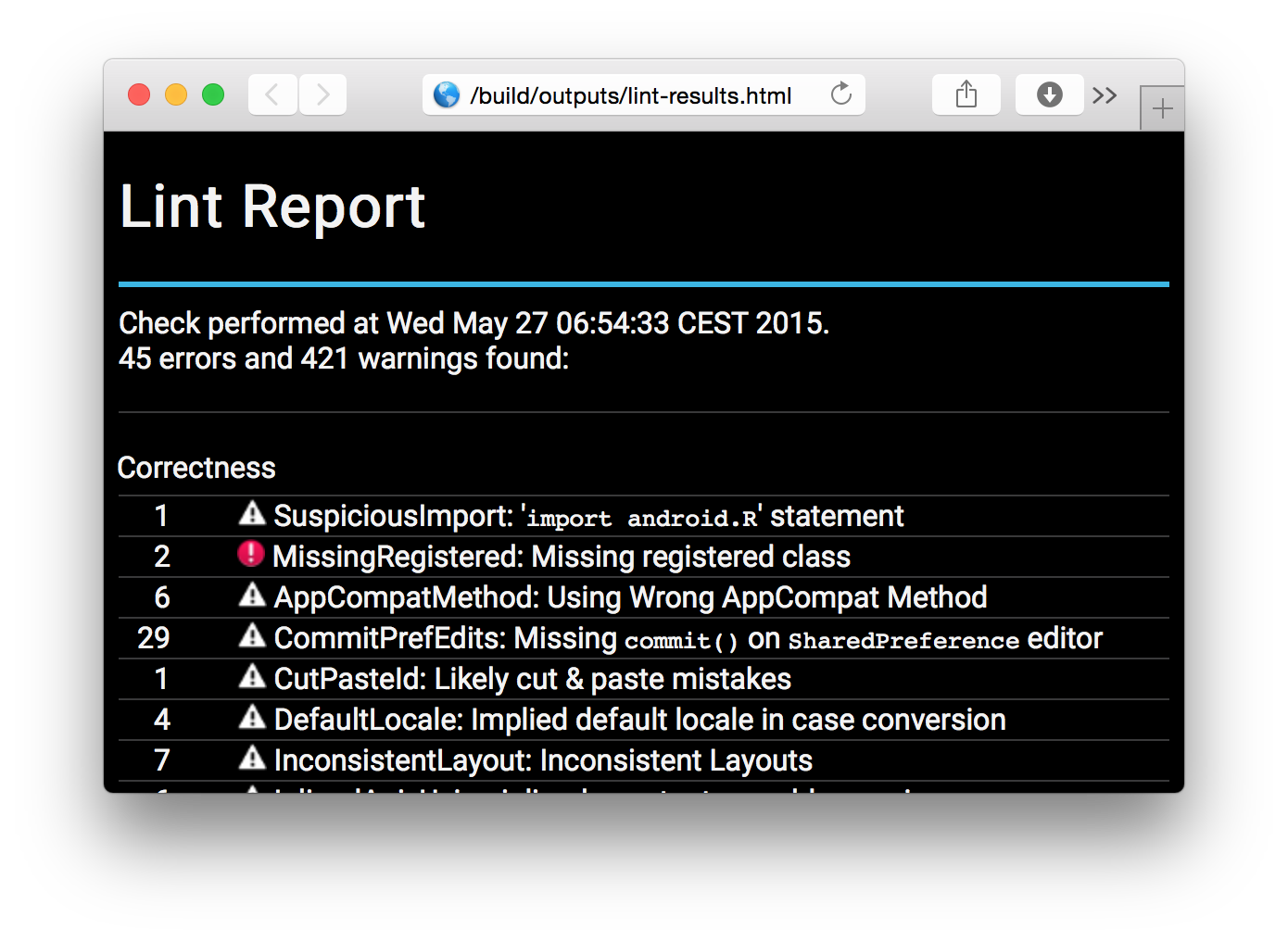
Custom rules
Motivation
- work in large and distributed teams requires dedicated conventions
- huge code bases require automated checks
- need for 'Android specific' validations
(vs. checkstyle, FindBugs, ...) - ...
Challenges
Writing custom Lint rules
- poor documentation
- bad testability
Lint API basics
Core principles of the Lint API
IssueDetectorScannerIssueRegistry
Issue
An
Issueis a type of problem you want to find and show to the user.
Issue
- registered in an
IssueRegistry - reported by a
Detector - final class
- created by static factory method
- has certain attributes, such as
SeverityScope- ...
Example
public static final Issue ISSUE = Issue.create(
"HelloWorld", //ID
"Unexpected application title", //brief description
"The application title should" //explanation
+ "state 'Hello world'",
Category.CORRECTNESS, //category
5, //priority
Severity.INFORMATIONAL, //severity
new Implementation( //implementation
HelloWorldDetector.class, //detector
Scope.MANIFEST_SCOPE //scope
)
);
Detector
A
Detectoris responsible for scanning through code and findingIssueinstances and reporting them.
Detector
- implementation of a Lint rule
- analyzes development artifacts
- reports
Issues - specialized by
Scanners
Example
public class HelloWorldDetector extends Detector
implements XmlScanner {
public static final Issue ISSUE = Issue.create(...);
@Override public Collection<String> getApplicableElements() {...}
@Override public Collection<String> getApplicableAttributes() {...}
@Override public void visitElement(@NonNull XmlContext context,
@NonNull Element element) {...}
@Override public void visitAttribute(@NonNull XmlContext context,
@NonNull Attr attribute) {...}
}
Scanner
A
Scanneris a specialized interface forDetectors.
Scanner types
JavaScannerClassScannerBinaryResourceScannerResourceFolderScannerXmlScannerGradleScannerOtherFileScanner
Example
| JavaScanner | XmlScanner |
|---|---|
applicableSuperClasses() |
getApplicableElements() |
checkClass(...) |
visitElement(...) |
getApplicableMethodNames() |
getApplicableAttributes() |
visitMethod(...) |
visitAttribute(...) |
| ... | ... |
IssueRegistry
An
IssueRegistryis a registry which provides a list of checks to be performed on an Android project.
IssueRegistry
- subclass
IssueRegistry - override
getIssues() - reference in
MANIFEST
jar {
manifest {
attributes 'Lint-Registry':
'your.package.name.CustomIssueRegistry'
}
}
Example
public class CustomIssueRegistry extends IssueRegistry {
@Override
public List<Issue> getIssues() {
return Arrays.asList( //Note:
MyCustomCheck.ISSUE, //A check actually is a detector.
MyAdvancedCheck.AN_ISSUE, //One detector can report
MyAdvancedCheck.ANOTHER_ISSUE //multiple types of issues.
);
}
}
Hands-on
- Getting started
- Detectors
- Testing
- Application
Getting started
github.com/a11n/CustomLintRulesWorkshop
$ git clone https://github.com/a11n/CustomLintRulesWorkshop.git
$ cd CustomLintRulesWorkshop
$ git checkout -f section-1
Pro tips
- have a look at the default set of checks
- use
SdkConstantswherever possible - utilize
LintUtilswhen applicable
Detectors
- Simple detectors
- Advanced detectors
Simple detectors
- scan isolated artifacts of one type
(e.g. just code or just resources) - perform scan and evaluation in one phase
Advanced detectors
- scan related artifacts of different types
- perform scan and evaluation in two phases
Testing
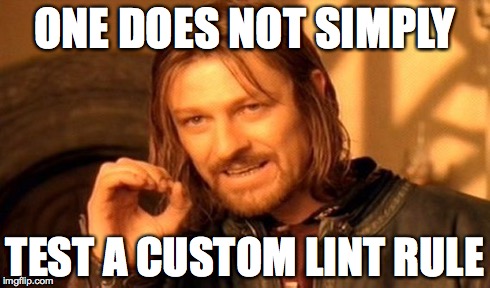
Testing
No official test supportofficial test support since last week's Google I/O
not working (see #175161)- Lint JUnit rule (still in beta)
Testing
LintDetectorTest
public class HardcodedValuesDetectorTest extends AbstractCheckTest {
@Override
protected Detector getDetector() {
return new HardcodedValuesDetector();
}
public void testStrings() throws Exception {
assertEquals(
"res/layout/accessibility.xml:3: Warning: [I18N] Hardcoded string \"Button\", should use @string resource [HardcodedText]\n" +
" <Button android:text=\"Button\" android:id=\"@+id/button1\" android:layout_width=\"wrap_content\" android:layout_height=\"wrap_content\"></Button>\n" +
" ~~~~~~~~~~~~~~~~~~~~~\n" +
"res/layout/accessibility.xml:6: Warning: [I18N] Hardcoded string \"Button\", should use @string resource [HardcodedText]\n" +
" <Button android:text=\"Button\" android:id=\"@+id/button2\" android:layout_width=\"wrap_content\" android:layout_height=\"wrap_content\"></Button>\n" +
" ~~~~~~~~~~~~~~~~~~~~~\n" +
"0 errors, 2 warnings\n",
lintFiles("res/layout/accessibility.xml"));
}
}
Testing
Lint JUnit rule
@Rule public Lint lint = new Lint();
@Test
public void test() throws Exception {
lint.setFiles("AndroidManifest.xml", "res/values/string.xml");
lint.setIssues(MyCustomRule.ISSUE);
lint.analyze();
List<Warning> warnings = lint.getWarnings();
assertThat(warnings).hasSize(2);
}
Application
- Basic approach
- Integrated approach
Basic approach
- utilizes basic Lint extension feature
- two steps setup
- assemble custom Lint rules into JAR
- copy JAR to
~/.android/lint/
Basic approach
#!/bin/sh
# Build .jar
./gradlew assemble
# Install
if [ ! -d "~/.android/lint/" ]; then
mkdir ~/.android/lint/
fi
cp build/libs/lint.jar ~/.android/lint/
Basic approach
| Pros | Cons |
|---|---|
| just assemble and copy | no straightforward distribution and configuration |
| one resulting JAR | no project-specific rules |
| no changes in the project to analyze | inconvenient for multi developer teams |
| applied for all analyzed projects | inconvenient for CI environments |
Integrated approach
- uses AAR bundle as wrapper
- two steps setup
- wrap custom Lint rules into an AAR
- make application project depend on that AAR
Three options for dependencies
- Copy the AAR to the libs folder
dependencies {
compile fileTree(dir: 'libs', include: '*.jar')
}
- Deploy the AAR to a repository
dependencies {
compile 'your.package.name:custom-lint:1.0.0@aar'
}
Three options for dependencies
- Have a Java module for the Lint rules and an Android library module as wrapper
Android application project
--app //default Android application module
--lint //Android library, acts as wrapper for the Lint rules
--lintrules //Java module with your custom Lint rules
project.afterEvaluate {
def compileLint = project.tasks.getByPath(':lint:compileLint')
compileLint.dependsOn ':lintrules:jar'
compileLint << {
copy{
from '../lintrules/build/libs'
into 'build/intermediates/lint'
}
}
}
Integrated approach
| Pros | Cons |
|---|---|
| allows project specific rules | changes in project required |
| integrated within project | not applied for all analyzed projects |
| ideal for multi developer teams | (no official documentation on how to wrap into AAR bundle available) |
| perfect for CI environments |
Real world scenarios
- Placeholder
- Naming conventions
- Activity/Fragment class names
- Layout names
- String references
- ID prefixes
Placeholder
- used for layout purposes
- help to get a meaningful overview
- present applied styles
- show wrapping
Example
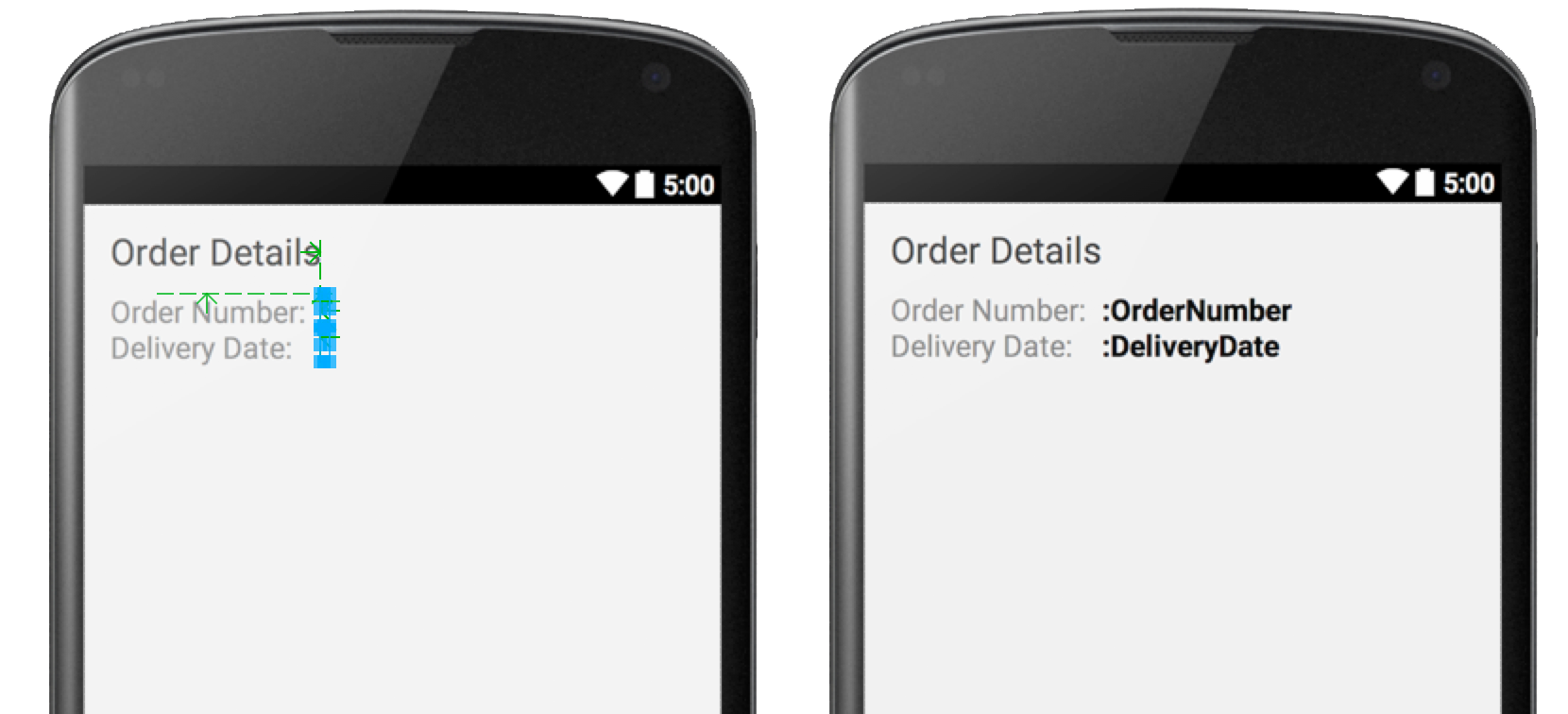
Example
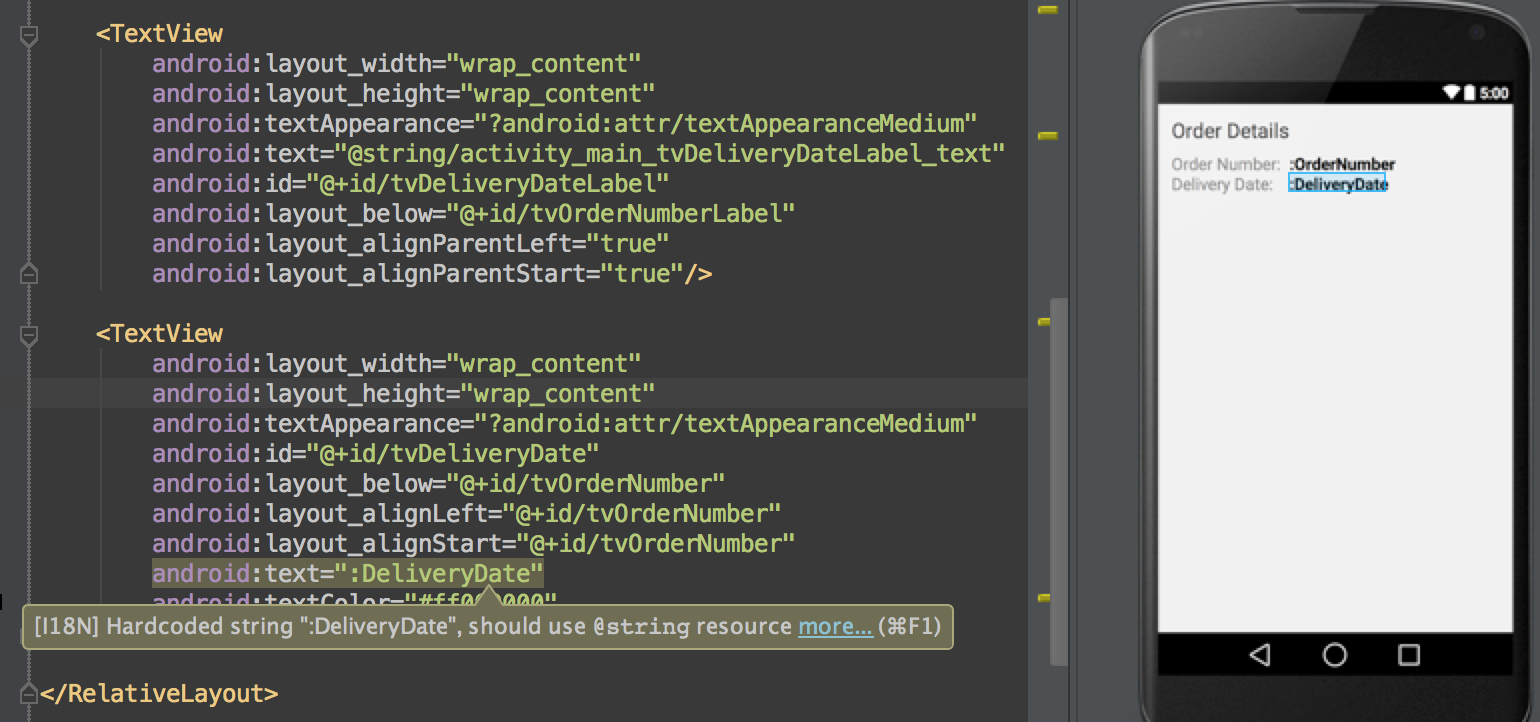
Naming conventions
Activity/Fragment class names
| Natural names | Conventional names |
|---|---|
...ConsumedMaterialsActivityCustomerSignatureFragmentOrderConfirmationFragmentOrderDataModelOrderReportActivityOrderReportViewModelVanStockMaterialFragment... |
...ActivityConsumedMaterialsActivityOrderReportFragmentCustomerSignatureFragmentOrderConfirmationFragmentVanStockMaterialModelOrderDataViewModelOrderReport... |
Layout names
- should express where they are going to be used
- Examples:
activity_order_status.xmlfragment_customer_details.xmllist_item_purchase_order.xml
String references
From experience, string references
- should be tied to a widget in a 1:1 relation!!
- reduces semantical incorrectness
- allows outsourcing of translation process
- may be refined by literals to avoid redundancy
- could be declared in distinct and dedicated files
Example
<!-- fragment_customer_signature.xml -->
<TextView android:id="@+id/tvCustomerName"
android:text="@string/fragment_customer_signature_tvCustomerName_text" />
<EditText android:id="@+id/etCustomerName"
android:hint="@string/fragment_customer_signature_etCustomerName_hint" />
<Button android:id="@+id/btSubmit"
android:text="@string/fragment_customer_signature_btSubmit_text" />
<!-- string.xml -->
<string name="fragment_customer_signature_tvCustomerName_text">
Please enter the customer name:
</string>
<string name="fragment_customer_signature_btSubmit_text">
@string/literal_submit
</string>
ID prefixes
- infer semantics
- on widget types
- on inter-widget relations
- speed up code completion
<RelativeLayout android:id="@+id/llCustomerDetails" ... >
<ImageView android:id="@+id/ivCustomerName" ... />
<TextView android:id="@+id/tvCustomerName" ... />
<EditText android:id="@+id/etCustomerName" ... />
...
<Button android:id="@+id/btSubmit" ... />
</RelativeLayout>
Summary
- custom Lint rules are written by extending
Detectorsand implementingScanners - complex rules have a scan and an evaluation phase
- Lint API provides convenient access to different types of development artifacts
- AAR format allows easy deployment and project-related rules
What's next
- release of reference guide for creating custom Lint rules
- improving Lint JUnit rule
- extending API
- advanced
LintUtils - advanced
BaseDetectors
- advanced
- encourage for more exchange
(e.g. on StackOverflow)